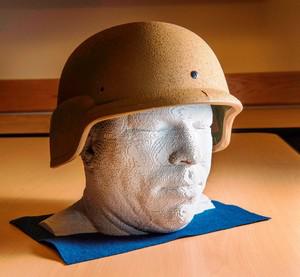Personal protection gearBlast, impact simulations help researchers better understand injuries and body armor
Researchers at Sandia Lab have studied the mechanisms behind traumatic brain injury for about a decade. Their traumatic injury modeling and simulation project began with a head-and-neck representation, and now they’ve created a high-fidelity, digital model of a man from the waist up to study the minute mechanisms behind trauma. The specialized computer modeling and simulation methods help researchers better understand how blasts on a battlefield could lead to traumatic brain injury and injuries to vital organs, like the heart and lungs.

Computer simulations seek design of better helmets // Source: flickr.com/yahoo.com
Sandia National Laboratories is developing specialized computer modeling and simulation methods to better understand how blasts on a battlefield could lead to traumatic brain injury and injuries to vital organs, like the heart and lungs.
Researchers at Sandia have studied the mechanisms behind traumatic brain injury for about a decade. Their traumatic injury modeling and simulation project began with a head-and-neck representation, and now they’ve created a high-fidelity, digital model of a man from the waist up to study the minute mechanisms behind trauma.
“We’re also concerned about the possibility of injury to the life-support systems in the torso. Everything’s interconnected,” said Paul Taylor, who leads the project. “Clearly, we would love to have a representation of a full human but certainly capturing all the regions where life-critical organs are located is a very good start.”
The information could help manufacturers develop better designs for helmets and body armor.
“Protection of the soldier, sailor or marine is essential, and well aligned with our national security mission against challenging and new lethal threats,” said program manager Doug Dederman. “It is a privilege for our integrated military systems staff to team with the Department of Defense and medical communities to improve both diagnostic capabilities and mitigation of risk with improved protective equipment.”
Sandia Lab says that Sandia’s most recent work grew from a Laboratory Directed Research and Development-funded project that wrapped up in late 2016. Along the way, the team conducted both macroscale and microscale traumatic brain injury simulations, began working with doctors to correlate simulation predictions with clinical assessments of people with brain injury and increased the size of their team.
They theorize that a phenomenon called fluid cavitation can lead to traumatic brain injury. They’ve developed macroscale simulations to test the hypothesis and extended their work into microscale studies to examine whether blast and short-pulse blunt impact, such as a projectile hitting body armor, could lead to fluid cavitation, forming bubbles whose collapse could damage sensitive brain and lung tissue, Taylor said.
